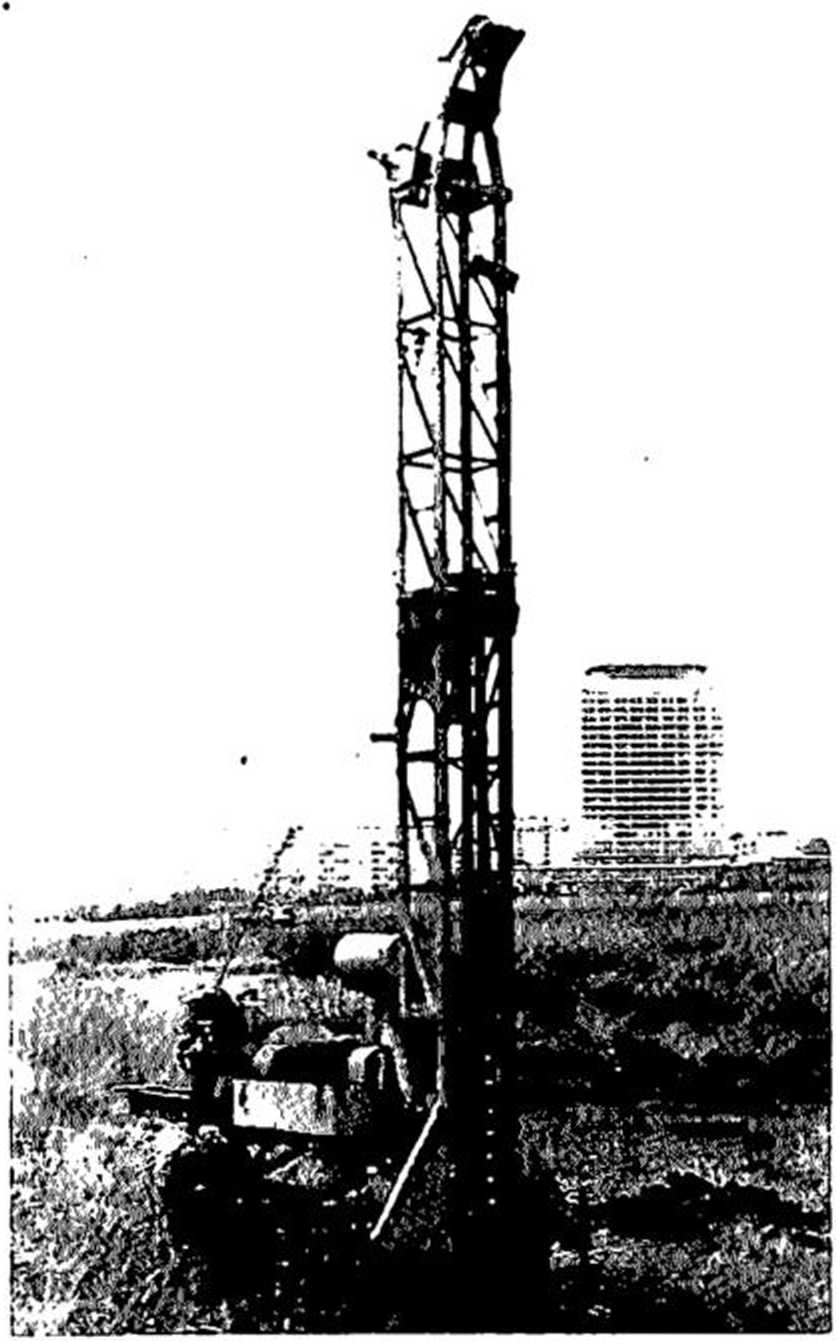6585844952
ESOPT
State-of-the-art report
Penetration testing in USSR
J.G. Trofimenkov
I. THE BACKGEOOND ON THE OSE OF PENETR0METER3
About 20 years ago. the mass oonstruc-tion of apartment buildings from prefab-rlcated reinforced concrete unita began in the USSR* The new typa of buildings reąuired the new type of foundations0 At that time the pile foundations on driven piles oame to a wide use. The use of this type of foundations reduces the vo-luae of earthwork by 8everal times and decreases the volume of conorete by two times as compared with shallow foundations*
The wide use of the pile foundations reąuired numerous inve9tigations for the determlning of the pile size (cross sec-tion and length) and their bearing capuci-ty. This problem was solved to a great ertent due to the wide use of the static sounding apparatus. Later, further inc-rease of the data of sounding and tradi-tional methods of investigations madę it possible to use the data of the statio sounding for the determlning of some mechanical properties of soils and the bearing capacity of shallow foundations* The dynamie sounding was used some-what earlier than the static sounding for the deteraination of the density of sand soils in hydrotechnical construction.
It is interesting to notę that the first investigation of the soil of the Uoon (Cherkasoy, Mikheey et al.,1970) was madę by the penetration tests in 1966 by the automatic station "Luna-13".
Now penetration tests are approved by State organizations for wide use: the bearing capacity of drlven piles by the data of static sounding is designed ac-cording to the Bullding Standard on design ing of pile foundations (1965)» the soil properties are evaluated by the Instruotion on penetration testing for construction (1972)*
The dynamie and static soundings are used together with the engineering and geological investigations of soils for: diatinguishing engineering and geolo-
fical layers,
etermining homogeneity of soils, determlning the depth to rock: or firm layer,
evaluating of mechanical properties of soils (density,angle of internal friction,modulus of defomation), determlning the bearing capacity of driven piles,
determinlng the ratę of consolidation and strengthening of fili soils with time*
The dynamie and statio soundings are not recommended to use in sand and olay soils oontaining moro than 40 per cent of debris (dynamie sounding) and morę than 25 per cent (static sounding)* The dynamie sounding is not also recommended to use in silty saturated sands and soft and very soft clays
2. DESCRIPTION OP HSKETR0METER8
Por dynamie sounding the apparatus UBB-15 (boring and sounding apparatus), developed by "Hydroprojeot* is nainly used (Pig*I)*

Pig*I* Boring and sounding apparatus-UBP-15
The sounding is madę ty raTiming the set of rods with the conioal tip at the end into the soil* The raamlng is madę by means of blows of the hammer weighlng 60 kg and falling from the height of 80 cm* Thus, the energy of a blow is 480 kg cm, i*e* almost the same as in standard penetration test* The sounding rod seotions are 1*5 m long, joined by coupllng, and their diameter is 42 mm* The cone is 74 ma in diameter with the apez angle of 60° • The o one can be with-drawn from the soil together with the rods or laft in the soil* This apparatus is also used fer parcussion drilling of holes 108-168 mm in diameter* The depth of boring is up to 15 m and the depth of souuuing is up to 20 m*
Besides the main hammer of 60 kg9 the llght hammer of 30 kg falling rram the height of 40 cm and the heavy hammer of 120 kg falling from the height of 100 cm are used*
Wyszukiwarka
Podobne podstrony:
ESOPT State-of-the-art reportPenetration testing in SpainV. Escario 1. INFLUENCE O
ESOPT State-of-the-art reportPenetration testing in TurkeyH. T. Durgunoglu & E. Togrol The stand
ESOPT State-of-the-art reportPenetration testing in CanadaW.J. Eden Because of the size of the count
ESOPT State-of-the-art reportPenetration testing in IndiaM.D. Desai, G.R.S. Jain, Swami Saran &
ESOPT State-of-the-art reportPenetration testing in IsraelA. Komornik The most common type of penetr
ESOPT State-of-the-art reportPenetration testing in JapanT. Muromachi, I. Oguro & T. Miyashita T
ESOPT State-of-the-art reportPenetration testing in USAJ.H. Schmertmann Because of Its versat1l1ty t
ESOPT State-of-the-art reportPenetration testing in CzechoslovakiaK. Drozd & M. Svasta The devel
Penetration testing in Portugal esoptJ. Folque State-of-the-art
Penetration testing in Sweden esoptR. Dahlberg State-of-the-art
Penetration testing in Australia esoptJ.C. Holden State-of-the-a
Penetration testing in South Africa esoptD.L. Webb State-of-the-
Penetration testing in Denmark esoptA. Hansen State-of-the-art
Penetration testing in Netherlands esoptW.J. Heijnen State-of-th
Penetration testing in Norway esoptK. Senneset State-of-the-art
RCA HOME VIDEO CAMERASNO ONE GIlfESYOU MORĘ PROFESSIONAL RESULTSTHE STATE-OF-THE-ART IN FEATURES. Vi
00100 ?e6667c29dfdea3c59f1657bb3f2b02 99 The OCAP manufacturing process remains in an unknown State
TWO DIFFERENT STATE OF MOBILE SCENE This is the functional character of the mobile scene. In this fo
Architecture Art Nouveau architecture in Riga makes up roughly one third of all buildings in the cen
więcej podobnych podstron